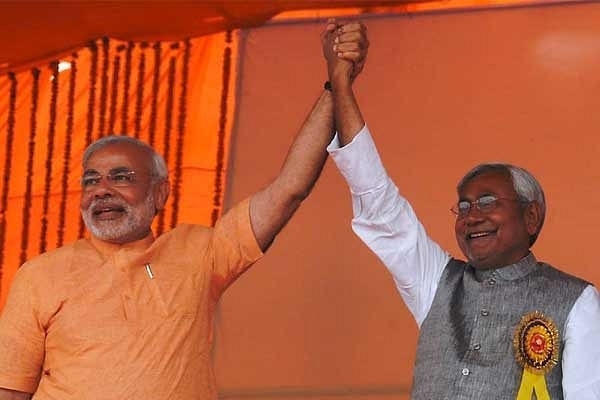
Miles To Go - Explaining Bihar's Recent Economic Growth
The progress made by Bihar in areas of construction, public services, and improved telecommunication have been the key drivers in this spurt of growth. But is it enough to keep the economy on a path of sustained double-digit economic growth?
Bihar has emerged as one of the fastest growing states in India in the last decade. While a lot of it can be attributed to the low base that the economy was being subject to, the relative sustainability of double-digit growth in Bihar’s economy between 2006-2014 is nonetheless impressive. The progress made by Bihar in areas of construction, public services, and improved telecommunication have been the key drivers in this spurt of growth, but we must question whether it is enough to keep the economy on a path of sustained double-digit economic growth.
First, even with such impressive growth credentials, Bihar continues to lag significantly behind the national figures when it comes to absolute income. Bihar currently has a per capita GDP slightly higher than INR 36,000, which is considerably below India’s per capita GDP of over INR 87,000. This leaves a very large gap for Bihar’s population to overcome. For instance, if India’s per capita GDP continues to increase at 10% for next two decades, Bihar will need its per capita growth to be around 15%, for it to reach the average Indian levels. This daunting task seems quite uphill, and Bihar’s growth strategy for next 20 years needs to be designed to fill up this gap.
Figure 1: Bihar has done well in terms of GDP growth, but still remains last in terms of national average
Source: MOSPI, RBI
Why Has Bihar grown so rapidly in last decade?
Almost everyone acknowledges that rule of law post-2005 and improvement in public services and roads construction have been the key driver of growth in Bihar in the last decade. But it is important to quantify the extent of change. When one looks through the data, the story becomes amply clear. Bihar has benefitted considerably from factors both global and local in nature.
For instance, transport and telecom sector in Bihar has grown roughly 4 times in size in Bihar between 2005 to 2015. This is something that was likely happening in India, and with improvement in connectivity, Bihar benefited disproportionally in this field. The impact of a stable government is perhaps most reflected in areas of public services and construction, both of which grew 1.9x and 4.7x in the same period, underlining what a government with rule of law can achieve in India’s backward states.
Figure 2: Bihar’s growth has been largely services driven
Source: MOSPI, RBI
What has Bihar’s growth model been unable to achieve?
The answer simply is agricultural growth. A distinguishing feature of new age growth states in India, like Madhya Pradesh, Gujarat and Chhattisgarh has been their ability to improve agricultural productivity. Bihar, while it has outstripped these states in GDP growth, it has failed to see significant improvement in agriculture sector. In fact, amongst the states who have done well in agriculture recently, Bihar’s performance has been somewhat lacklustre. This means that with poor prospects in agriculture, and lack of a manufacturing base, Bihar’s growth drivers are starting to run out.
Figure 3: Bihar’s agriculture growth performance is not as envious as its headline growth
Source: MOSPI, RB
What can drive Bihar’s next leg of economic growth?
Bihar’s economic activity expansion cannot be sustained merely on improvement in public services and road/telecom connectivity in the coming decades. In its reforms cycle, Bihar and its policymakers need to think of where economic growth and more importantly, jobs will come from in the next two decades, as it tries to play catch up with the rest of India.
First, Bihar needs a strategic narrative around economic growth. While rule of law and social order was perhaps one in the last decade, Bihar seems to be regressing in its narrative, not moving forward. With political headwinds increasing, Bihar’s polity is again turning towards casteism and special packages, instead of providing a path of development and economic prosperity to find favour from voters. This can be easily countered, with a message of economic growth, with special focus areas outlined clearly.
Second, Bihar is in a strong position to take advantage of low-cost manufacturing. Bihar’s young labour force, large border with key neighbours such as Nepal, Bhutan and connectivity with Bangladesh gives it a perfect base to scale up its manufacturing sector. If under a reformist government, Bihar’s labour laws and industrial access are improved, Bihar can embark on the second phase of its growth cycle, i.e. industrialisation. While it may sound daunting, states such as Madhya Pradesh, Rajasthan and Odisha are currently undergoing the same dynamic, so Bihar can lean on similar examples.
Third, Bihar’s agricultural productivity needs to rise sharply. Despite being on the most fertile plains of Ganga, Bihar continues to languish with poor agriculture performance and faces constant floods during the monsoon seasons. With a focused approach, Bihar’s problem of low agricultural growth and perennial floods can be solved, with canals and irrigation projects being taken up on a mission mode. This can have other positive externalities, as water availability coupled with small water purification systems can improve health outcomes in villages as well, particularly reducing incidence of water-borne diseases.
Overall, Bihar remains an important part of India’s rate of growth, and without Bihar’s economy booming, India will not be able to hit double-digit growth anytime soon. As such, Bihar needs bipartisan support to grow faster, and irrespective of the upcoming election results, Bihar needs to find sectors of competitiveness, which can in turn create productive jobs in private sector. As we had noted earlier, the real challenge for Bihar is to catch up with India’s average income levels, and for that to be achieved in next two decades, requires considerable amount of focus, planning and execution.